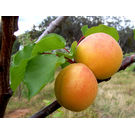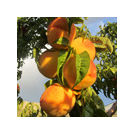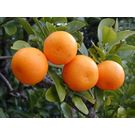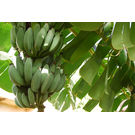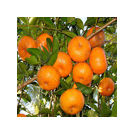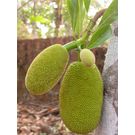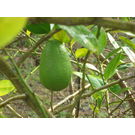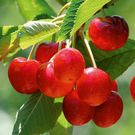Pomegranate / Anar Plant

Description
An attractive shrub or small tree, to 20 or 30 ft (6 or 10 m) high, the pomegranate is much-branched, more or less spiny, and extremely long-lived, some specimens at Versailles known to have survived two centuries. It has a strong tendency to sucker from the base. The leaves are evergreen or deciduous, opposite or in whorls of 5 or 6, short-stemmed, oblong-lanceolate, 3/8 to 4 in (1-10 cm) long, leathery. Showy flowers are home on the branch tips singly or as many as 5 in a cluster. They are 1 1/4 in (3 cm) wide and characterized by the thick, tubular, red calyx having 5 to 8 fleshy, pointed sepals forming a vase from which emerge the 3 to 7 crinkled, red, white or variegated petals enclosing the numerous stamens. Nearly round, but crowned at the base by the prominent calyx, the fruit, 2 1/2 to 5 in (6.25-12.5 cm) wide, has a tough, leathery skin or rind, basically yellow more or less overlaid with light or deep pink or rich red. The interior is separated by membranous walls and white spongy tissue (rag) into compartments packed with transparent sacs filled with tart, flavorful, fleshy, juicy, red, pink or whitish pulp (technically the aril). In each sac, there is one white or red, angular, soft or hard seed. The seeds represent about 52% of the weight of the whole fruit.
Pollination
The pomegranate is both self-pollinated and cross-pollinated by insects. There is very little wind dispersal of pollen. Self-pollination of bagged flowers has resulted in 45% fruit set. Cross-pollination has increased yield to 68%. In hermaphrodite flowers, 6 to 20% of the pollen may be infertile; in male, 14 to 28%. The size and fertility of the pollen vary with the cultivar and season.
Climate
The species is primarily mild-temperate to subtropical and naturally adapted to regions with cool winters and hot summers, but certain types are grown in home dooryards in tropical areas, such as various islands of the Bahamas and West Indies. In southern Florida, fruit development is enhanced after a cold winter. Elsewhere in the United States, the pomegranate can be grown outdoors as far north as Washington County, Utah, and Washington, D.C., though it doesn't fruit in the latter locations. It can be severely injured by temperatures below 12º F (-11.11º C). The plant favors a semi-arid climate and is extremely drought -tolerant.
Soil
The pomegranate thrives on calcareous, alkaline soil and on deep, acidic loam and a wide range of soils in between these extremes. In northern India, it is spontaneous on rockstrewn gravel.
Propagation
Pomegranate seeds germinate readily even when merely thrown onto the surface of loose soil and the seedlings spring up with vigor. However, to avoid seedling variation, selected cultivars are usually reproduced by means of hardwood cuttings 10 to 20 in (25-50 cm) long. Treatment with 50 ppm. indole-butyric acid and planting at a moisture level of 15.95% greatly enhances root development and survival. The cuttings are set in beds with 1 or 2 buds above the soil for 1 year, and then transplanted to the field. Grafting has never been successful but branches may be air-layered and suckers from a parent plant can be taken up and transplanted.
Harvesting and Yield
The fruits ripen 6 to 7 months after flowering. In Israel, cultivar 'Wonderful' is deemed ready for harvest when the soluble solids (SSC) reach 15%. In California, maturity has been equated with 1.8% titratable acidity (TA) and SSC of 17% or more. The fruit cannot be ripened off the tree even with ethylene treatment. Growers generally consider the fruit ready for harvest if it makes a metallic sound when tapped. The fruit must be picked before over maturity when it tends to crack open if rained upon or under certain conditions of atmospheric humidity, dehydration by winds, or insufficient irrigation. Of course, one might assume that ultimate splitting is the natural means of seed release and dispersal.
The fruits should not be pulled off but clipped close to the base so as to leave no stem to cause damage in handling and shipping. Appearance is important, especially in the United States where pomegranates may be purchased primarily to enhance table arrangements and other fall (harvest-time) decorations. Too much sun exposure causes sunscald–brown, russeted blemishes and roughening of the rind.
The fruit ships well, cushioned with paper or straw, in wooden crates or, for nearby markets, in baskets. Commercial California growers grade the fruits into 8 sizes, pack in layers, unwrapped but topped with shredded plastic, in covered wood boxes, precool rapidly, and ship in refrigerated trucks.


